
Kijiyama-style kokeshi dolls by Ikuo Nakakawa, who works in the Akita Prefecture.
Growing up near San Francisco in the 1960s, my earliest memories of kokeshi dolls were of the kitschy souvenirs sold at the Japanese Tea Garden in Golden Gate Park, as well as the orderly rows of identical, limbless wooden figures that lined the shelves of the tourist-trap gift shops at Fisherman’s Wharf. To my American-boy mind, kokeshi dolls held little interest, mostly because their delicately painted, rigid cylindrical forms seemed ill-suited to one of my favorite forms of childhood play—pushing my “well-loved” Tonka truck up and down a slope of dirt behind our house. In my hands, a handcrafted kokeshi doll wouldn’t have survived an afternoon.
“Shibu kawaii is a kind of cute that’s cute in a way that isn’t.”
Manami Okazaki grew up in Australia, almost as far from the land of kokeshi dolls as I did (San Francisco and Sydney are both 5,000 miles from Tokyo, give or take a few hundred). But unlike me, Okazaki developed a lifelong fascination with, and love of, kokeshi dolls, a passion that fills every page of her recent book, Japanese Kokeshi Dolls: The Woodcraft and Culture of Japan’s Iconic Dolls (Tuttle, 2021). Indeed, an affinity for kokeshi dolls is practically in her DNA.
“My mother is from a region called Tohoku,” Okazaki tells me over Zoom, referring to the part of Japan that occupies the northern third of Honshu, the country’s largest island. “I would visit Japan during the summer breaks for six weeks at a time, and during those breaks we’d go up to Tohoku to see the grandparents.”

Kochi Sato of Zao Onsen in Togatta is retired, but visitors can see a collection of his Yajiro-style kokeshi at his shop. Note the unfinished piece of wood at top left.
In 2011, Tohoku gained unwelcome international notoriety after an undersea earthquake sent a wall of salt water 20 feet high ashore, inundating more than 200 square miles of coastal Japan, including Okazaki’s mother’s family home. Also caught in the tsunami was the Fukushima Daiichi nuclear reactor, whose partial meltdown caused the evacuation of some 150,000 people for a dozen miles around.
Prior to the tsunami disaster, Tohoku was better known for its ski resorts and hot springs, or onsen, which are picturesquely situated in the region’s densely forested mountains. It was there that kokeshi dolls were first produced in the mid-19th century, most likely derived from the area’s deeply ingrained woodworking traditions. Initially, as Okazaki writes in Japanese Kokeshi Dolls, kokeshi commerce in the 19th century was directed at Japanese farm workers, who would take to the reinvigorating waters of onsen at Naruko, Tsuchiyu, and Togatta in the winter after a spring, summer, and fall of heavy labor in the fields. Of modest means, these workers nonetheless budgeted for the cost of a few kokeshi to bring home to their children and grandchildren, thus beginning the synergy of kokeshi dolls and tourism that I would experience a century or so later.
“I was introduced to kokeshi because of my mother’s family’s connection with Tohoku,” Okazaki continues. “On my summer breaks, we’d go to the hot-spring villages where kokeshi are made, just to see them. After the disaster, I returned to Tohoku quite often as a journalist. Kokeshi became kind of a mascot for the region. So this childhood toy, this memory from my past, suddenly came to the forefront of my consciousness again.”
Okazaki’s first book on kokeshi dolls was Kokeshi: From Tohoku With Love (Kingyo, 2013), which raised funds for a number of tsunami-relief organizations. “As with any disaster of that scale—in America, it would have been similar to September 11—you’re so bombarded with graphic, disaster images. You become a bit desensitized to it. But there was also this other side to Tohoku, so I wanted to express that aspect of the region as well.”
In Japanese Kokeshi Dolls, Okazaki delves into the history and manufacture of kokeshi, identifies its 12 traditional styles, touches on the talismanic and sensory qualities of the wood, interviews kokeshi artisans, or kojin, who open their workshops to visitors, and explores the work of several modern kojin, whose kokeshi incorporate everything from traditional Japanese elements such as kimono to the iconography of international mega brands like Hello Kitty and Star Wars.
We learn, for example, that dogwood, or mizuki, is one of several preferred woods for kokeshi, some of the others being maple, cherry, pagoda, and zelkova. Limbs from these trees are cut, stripped of their bark in the winter, and then left to dry in outdoor sheds for up to two years. “When you’re driving in Tohoku,” Okazaki tells me, “you can tell if someone makes kokeshi by the size of their wood shed.”

Zao-style kokeshi artisan Ikuo Okazaki paints the head of a large kokeshi doll in his studio at Zao Onsen.
The primary tool of the kojin is the lathe, or rokuro, which has been in use in Japan since at least the 9th century. Early lathes were powered by a rope that was wrapped around a shaft attached to the piece of dogwood, cherry, or zelkova being worked by the kojin. As the rope was pulled back and forth by the kojin’s apprentice, the lathe would turn one way and then the other, which meant the kojin would have to make their cuts in short, repeated bursts. Such hand-powered reciprocating lathes, as they’re called, were largely replaced in the 1890s by pedal-powered lathes, which freed the kojin’s apprentices to perform other tasks, such as forging the iron tools, or hamono, used to transform a piece of dry dogwood into a shapely, cylindrical kokeshi doll. More importantly, pedal-powered lathes spun in the same direction continuously, making these simple machines the forebears of the precision electric rotary lathes used by kojin today.
Lathes are also used for painting, creating aptly named lathe lines on many styles of kokeshi. These decorative horizontal stripes are sometimes applied to the shoulders and bases of dolls, framing hand-painted traditional designs such as chrysanthemums on a doll’s body. In other styles of kokeshi, lathe lines are the figure’s only decoration, save the hand-painted, minimalist details that subtly animate the doll’s face.
According to Okazaki, this push and pull between painstaking design and its virtual lack makes kokeshi dolls great toys. “Because kokeshi are so spare, they foster your imagination.” she says. “Unlike modern dolls like Barbie or Licca-chan, her equivalent in Japan, whose narratives are already set, you can create your own narratives around kokeshi. When I play video games on the PS2, it’s incredible,” she adds. “The graphics are amazing and you can get immersed in entire worlds, but nothing is left to the imagination.”

Akihiro Sakurai is a fifth-generation Naruko artisan. Visitors to his shop will often find him at his lathe.
For some, those narratives are pure poetry. “I interviewed Kokeshka, the owner of a kokeshi shop in Kamakura,” Okazaki says. “He likened kokeshi to haiku because both are so minimalistic and simple. With haiku, all it takes are a few lines to spark the imagination.” Similarly, a pair of parallel black arcs can become an eye and an eyebrow, while a solitary dot of red may be enough to signify a mouth. Other motifs are pulled from centuries of decorative art traditions and techniques, such as using quick sumi brush strokes to indicate hair.
Kokeshi and its traditional aesthetics came on the scene at a pivotal moment in Japanese history. In 1867, right around the time when Japanese farmers were starting to bring home kokeshi dolls from Tohoku for their kids, the Edo period ended. That opened Japan’s borders to the world, which, in turn, unleashed as economic tsunami of Western “progress” that swept across the island nation.
“Japan changed so much after that,” Okazaki says. “In the Edo period, the standard clothes had been kimonos. But in the Meiji era that followed, there was a kind of aspirational quality on the part of many Japanese toward the West, from wearing Western clothing to reading Western literature.”
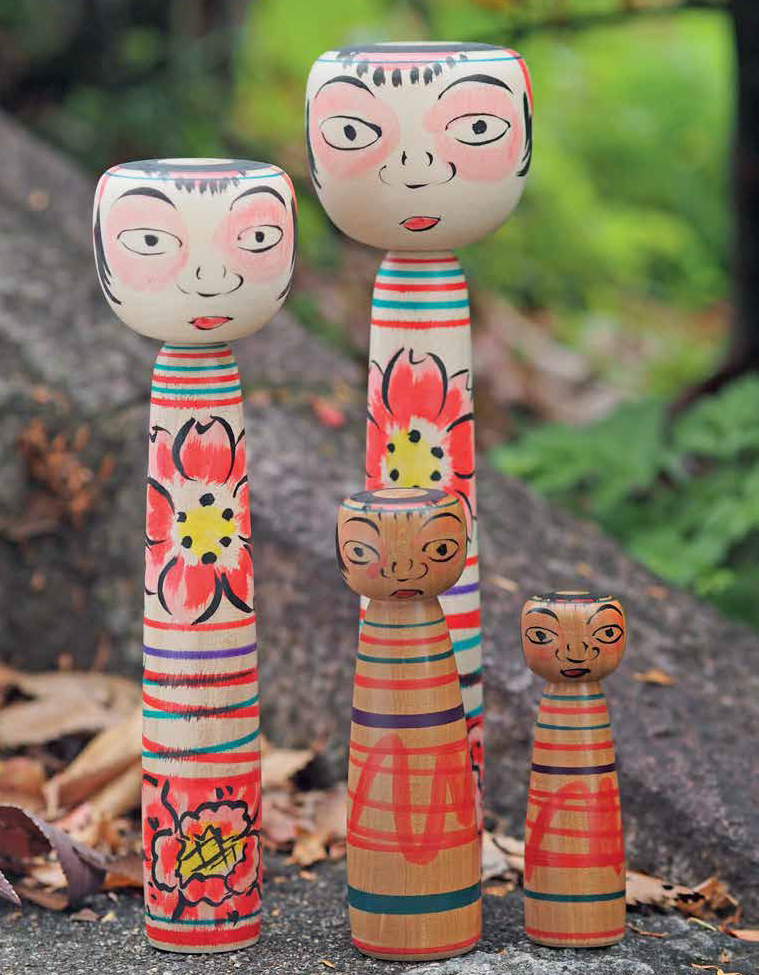
The haunting eyes of Nakanosawa-style kokeshi make them one of the least cute types of kokeshi dolls. These were made by Fumio Kakizaki.
In the face of such trends, Kokeshi remained stubbornly Japanese, a bulwark of sorts against both the influence of Western aesthetics and the insinuation of Western ideas around industrialization, particularly when it came to the virtues of worker specialization in manufacturing. Instead, kojin continued their centuries-old practice of apprenticeship, in which future kojin are taught how to choose wood, dry it, make the tools to shape it, make the brushes to paint it, and then use those brushes to artistic effect. That stubbornness proved good for kokeshi, which rode the tide of backlash against mass production and sparked an interest in folk crafts. “Some people in the Meiji era began to yearn for things that were imbued with a certain kind of handmade energy,” Okazaki says. Kokeshi provided that.
It didn’t hurt that kokeshi were also undeniably cute, defined more precisely by Okazaki as a type of “subdued” cute known as shibu kawaii. “Kawaii, the culture of cuteness, is probably the dominant pop-cultural aesthetic at the moment,” Okazaki tells me. “My bankcard has Hello Kitty on it. You see buses in the shapes of bears or pandas, airplanes in the shapes of dogs. It’s endless. But shibu kawaii is a kind of cute that’s cute in a way that isn’t—a retro or old-school cute.”
In other words, a level of cute that won’t give you diabetes. “I wrote a book on kawaii culture,” Okazaki says. “I spoke with designers from gaming companies whose work is 100-percent maximum cute. They told me that if you really want to see the roots of kawaii, you should check out kokeshi.”

Kokeshi has also been credited (or blamed, depending on how you look at these things) as the template for the mix of uniformity and variation found in everything from Be@rbrick toys to Pokemon. That may seem like a stretch if you are wondering what a kokeshi doll could possibly have in common with Pikachu or Bulbasaur, but the similarities have less to do with the decorations on the forms than the utility of the forms themselves as armatures for myriad variations.
Related: Investigating the Incredible Pokémon Card Market
Kokeshi collectors are drawn to these variations, as well as the imperfections within them. “One of the qualities of Japanese and Western craft alike is the value placed on the imperfections,” Okazaki says. Basically, an imperfection is proof that something was made by hand. “The eye of one doll might be slightly lower than the other,” Okazaki explains by way of example. “There’s always an element that’s just a little bit off, but that’s part of the appeal.”
That might have been good to know when I was looking at all those kokeshi dolls in all those Fisherman’s Wharf tourist traps through my little-boy eyes. Maybe if I’d known that the toys weren’t actually all that perfect and precious, I might not have been so uptight about the idea of a hand-painted, handmade wooden kokeshi doll riding shotgun in my beat-up Tonka.
(All photos courtesy “Japanese Kokeshi Dolls: The Woodcraft and Culture of Japan’s Iconic Dolls.” If you buy something through a link in this article, Collectors Weekly may get a share of the sale. Learn more. To watch a kokeshi doll being made by a kojin in Naruko, check out the video below.)


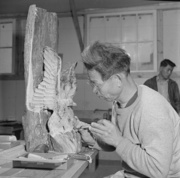 The Art of Dignity: Making Beauty Amid the Ugliness of WWII Japanese American Camps
The Art of Dignity: Making Beauty Amid the Ugliness of WWII Japanese American Camps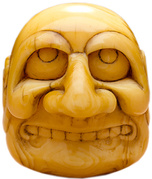
 Epic Ink: How Japanese Warrior Prints Popularized the Full-Body Tattoo
Epic Ink: How Japanese Warrior Prints Popularized the Full-Body Tattoo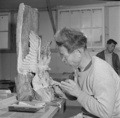 The Art of Dignity: Making Beauty Amid the Ugliness of WWII Japanese American Camps
The Art of Dignity: Making Beauty Amid the Ugliness of WWII Japanese American Camps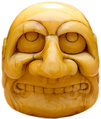 The Folklore and Fashion of Japanese Netsuke
The Folklore and Fashion of Japanese Netsuke Japanese DollsWhile “ningyo” or human figurines can be traced to ancient Japanese rituals…
Japanese DollsWhile “ningyo” or human figurines can be traced to ancient Japanese rituals… Kokeshi DollsSince World War II, Japanese kokeshi dolls have become tremendously popular…
Kokeshi DollsSince World War II, Japanese kokeshi dolls have become tremendously popular… Mari Tepper: Laying it on the Line
Mari Tepper: Laying it on the Line Nice Ice: Valerie Hammond on the Genteel Charm of Vintage Canadian Costume Jewelry
Nice Ice: Valerie Hammond on the Genteel Charm of Vintage Canadian Costume Jewelry How Jim Heimann Got Crazy for California Architecture
How Jim Heimann Got Crazy for California Architecture Modernist Man: Jock Peters May Be the Most Influential Architect You've Never Heard Of
Modernist Man: Jock Peters May Be the Most Influential Architect You've Never Heard Of Meet Cute: Were Kokeshi Dolls the Models for Hello Kitty, Pokemon, and Be@rbrick?
Meet Cute: Were Kokeshi Dolls the Models for Hello Kitty, Pokemon, and Be@rbrick? When the King of Comedy Posters Set His Surreal Sights on the World of Rock 'n' Roll
When the King of Comedy Posters Set His Surreal Sights on the World of Rock 'n' Roll How One Artist Makes New Art From Old Coloring Books and Found Photos
How One Artist Makes New Art From Old Coloring Books and Found Photos Say Cheese! How Bad Photography Has Changed Our Definition of Good Pictures
Say Cheese! How Bad Photography Has Changed Our Definition of Good Pictures Middle Earthenware: One Family's Quest to Reclaim Its Place in British Pottery History
Middle Earthenware: One Family's Quest to Reclaim Its Place in British Pottery History Fancy Fowl: How an Evil Sea Captain and a Beloved Queen Made the World Crave KFC
Fancy Fowl: How an Evil Sea Captain and a Beloved Queen Made the World Crave KFC
I love it! These dolls are similar to Russian Matryoshka’s. They’re also made of wood.